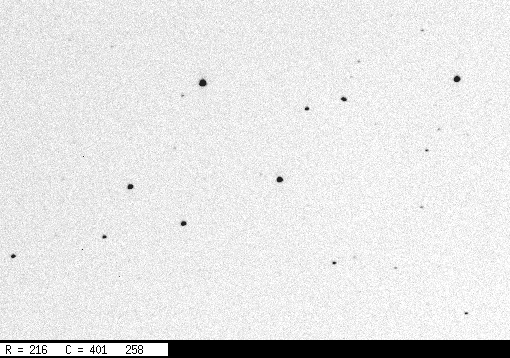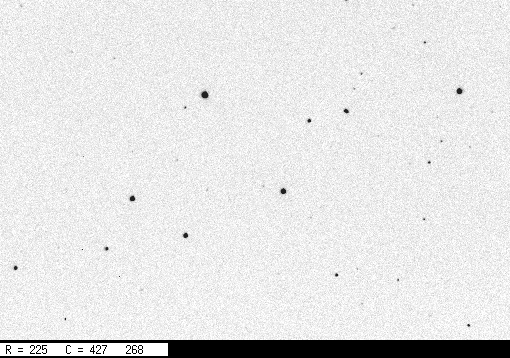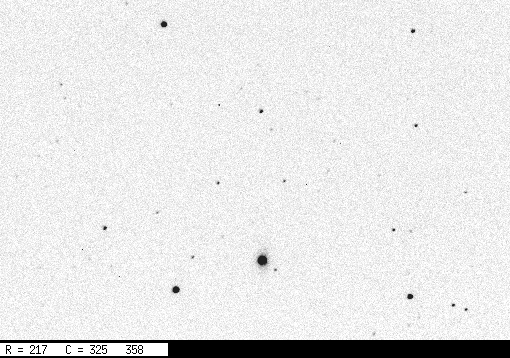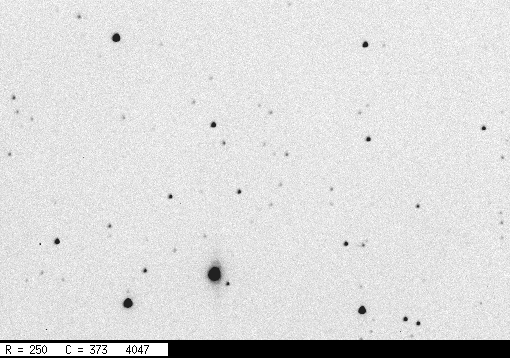

On Jun 15, 2003, EST, I went out to practice using the new 12-inch Meade LX-200 telescope, which replaces our 10-inch model in the dome building. My plans were to
All pictures were taken with the Meade 12-inch telescope, f/6.3 focal reducer, R-band filter and SBIG ST-8 CCD.
Using the CLEA software, I searched for targets near the meridian (and away from the rising full moon). A search for asteroids brighter than mag 17, located 3 hours West of opposition, within a radius of 5 degrees, yielded 15 matches. I've decided that the Lowell orbital database, ASTORB.DAT, is more useful than the MPC list because it provides more guidance to the priority of various targets. Most of the asteroids bright enough for us to see have well determined orbits.
My primary targets were asteroids Psyche, Arduina, Sternberga, Echo, and Eurynome. I managed to acquire the fields of 4 of the 5, missing only Echo. I "discovered" the fact that observing asteroids about 3 hours in RA away from opposition -- i.e., in quadrature -- means that they don't move across the sky very much; that makes them hard to verify by blinking. Well, duh.
Here's a pair of images of Psyche, taken 14 minutes apart. I warned you that the apparent motion is pretty small for objects near quadrature.


Click here to blink the images.
The asteroid is roughly magnitude 12. It's one of the brighter objects in this 20-second exposure.
Now, a fainter object: 995 Sternberga. This is around 15th magnitude. This time, I'll show a 20-second exposure (on the left) and a 200-second exposure taken 34 minutes later (on the right).


Click here to blink the images.
You can see that this fifteenth-mag object is pretty faint in the short exposure, but just fine on the longer exposure. Remember that the nearly full moon is low in the sky, so the sky is pretty bright. I decided that as a rough guide
The telescope will track fine for 20 seconds, but not for 40. I tried the autoguider. When I did the "Calibration" step, an error (or warning?) message popped up at the end .... but the autoguider kept the telescope right on the stars for several 200-second exposures. Great!
I cleaned the images the next morning, and ran the CLEA software on them all to perform astrometry. It told me that the setup I was using (12-inch Meade plus focal reducer plus filterwheel plus CCD camera binned 3x3) had
The finding charts produced by CLEA work best (as Larry Marschall told me) when on combines data from the GSC with the USNO-SA2.0. The latter, by itself, doesn't show enough of the brighter stars to allow easy field identication. Perhaps that's true only in the CLEA version of the catalog, which may have been trimmed to exclude the bright stars.
I typically ended up starting with around 10 reference stars in each image, but discarding 2-4 of them. The average residual from a linear plate solution was around 0.20-0.40 arcseconds in each direction. After I was done making measurements, the software produced a report in the standard format for submitting to the MPC. Here's my report, which I sent via E-mail this morning:
COD 920
TEL 0.3m f/6.3 reflector + CCD
CON M. Richmond, Rochester Institute of Technology, 85 Lomb Memorial Drive,
CON Rochester-NY-14623, USA
CON [mwrsps@rit.edu]
OBS M. Richmond
MEA M. Richmond
NET GSC, USNO-SA1.0
ACK Report Generated 2003-06-16 5:37:24 PM
00016 C2003 06 16.09875 14 42 16.98 -11 25 22.2 11.6 R 920
00016 C2003 06 16.10403 14 42 16.89 -11 25 21.6 11.7 R 920
00016 C2003 06 16.10868 14 42 16.79 -11 25 21.4 11.6 R 920
00394 C2003 06 16.12166 14 27 24.63 -12 24 35.3 14.4 R 920
00394 C2003 06 16.12664 14 27 24.52 -12 24 35.5 14.4 R 920
00394 C2003 06 16.13163 14 27 24.39 -12 24 35.3 14.3 R 920
00995 C2003 06 16.14098 14 29 27.47 -10 30 53.1 15.0 R 920
00995 C2003 06 16.14597 14 29 27.39 -10 30 51.2 14.9 R 920
00995 C2003 06 16.15291 14 29 27.29 -10 30 50.1 15.2 R 920
00995 C2003 06 16.16571 14 29 27.04 -10 30 46.0 14.7 R 920
00079 C2003 06 16.18412 13 43 29.86 -08 46 44.4 13.0 R 920
00079 C2003 06 16.19295 13 43 29.89 -08 46 43.5 13.3 R 920
00079 C2003 06 16.19891 13 43 29.85 -08 46 43.5 13.0 R 920
Overall, I'm very pleased. The new telescope has few quirks, so we should be able to use it right away. The CLEA software makes astrometry of asteroids (and other objects, too) a snap.
Last modified 6/17/2003 by MWR.